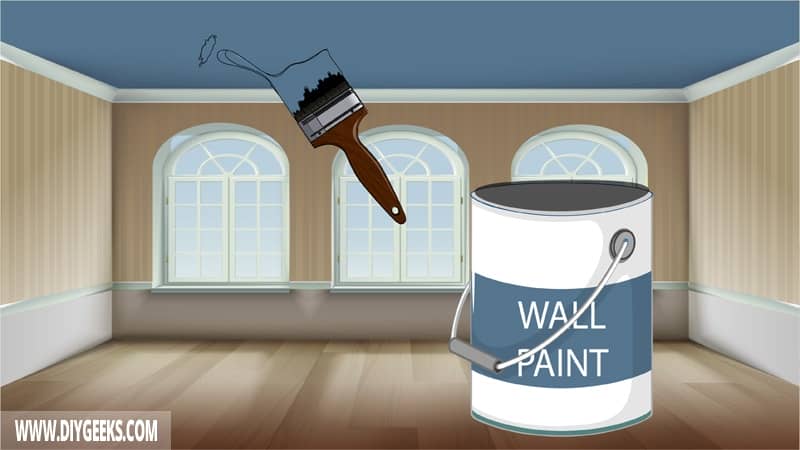You can apply ceiling paint on walls if you thin the paint first. Ceiling paint has a thick viscosity and you must thin it before applying it to walls.
The reasons you should apply ceiling paint on walls include better protection, the same color finish, or using it as a primer.
To apply ceiling paint on walls, prep the workspace, thin the ceiling paint, and apply the paint.
Ceiling Paint vs. Wall Paint
The differences between ceiling and wall paint are listed in the table below.
| Ceiling Paint | Wall Paint | |
|---|---|---|
| Paint flow | Thick | Light or Thin |
| Durability | Good | Average |
| Paint Coverage | Good | Poor |
| Paint Color | Comes in neutral colors | Comes in all colors |
| Paint Application | Moderate | Easy |
Ceiling paint has a thicker viscosity as it’s designed to adhere over ceilings without dripping to the ground. Since it has a thicker viscosity, ceiling paint is more durable, lasts longer, and has better coverage.
You can cover the whole ceiling surface with one (1) ceiling paint coat. In comparison, you need 2-3 wall paint coats to cover the ceiling without the paint dripping to the ground.
However, wall paint has a better color range and finishes as it’s formulated with more paint pigments.
Why Should You Use Ceiling Paint Over Walls?
You should use ceiling paint over wall surfaces for the following reasons.
- Better Protection: Ceiling paints are thicker and adhere to surfaces better, so they offer more protection compared to interior wall paints.
- Same Color Finish: If you want the room to have the same paint finish color shade and sheen, use ceiling paint for walls too.
- Use it as a Primer: Since ceiling paint is thick, you can use it as a basecoat (or undercoat) before applying the wall paint. Ceiling paint will cover holes, cracks, and imperfections.
- Hide Imperfections: The thick ceiling paint viscosity can cover imperfections and holes in the surface.
Can You Mix Ceiling Paint with Wall Paint?
You can mix ceiling paint with wall paint if both paints have the same base (solvent). For instance, you can mix water-based ceiling paint with water-based wall paint.
Their mixture will produce a colorful and thick paint that adheres to ceiling surfaces without drips.
If paints have a different solvent (water or oil) you can’t mix them as the mixture will produce an inconsistent paint finish.
You should never mix water-based ceiling paint with the following.
- Oil-based paint.
- Sealers (polyurethane, varnish, wax, etc).
- Oil-based primers.
How To Apply Ceiling Paint On Wall Surfaces?
To apply ceiling paint on wall surfaces, do the following things.
- Prep the Workspace.
- Thin the Ceiling Paint.
- Apply the Paint.
1. Prep the Workspace
Prep the workspace by covering the floor with a large drop sheet to prevent paint spills or stains and moving nearby objects or furniture.
Clean the wall surfaces with warm soapy water to remove dust, dirt, or stains that can prevent ceiling paint from adhering.
2. Thin The Ceiling Paint
You must thin ceiling paint before applying it over wall surfaces as the paint is too thick.
To thin ceiling paint, do the following things.
- Use water (for water-based types) or mineral spirits (for oil-based types).
- Add 1/2 cup of thinner to the paint or mix it in a ratio of 1:3 (1 part water to 3 parts paint thinner).
- Stir the mixture using a turning stick or paint mixer for 5 minutes.
Once the paint is thinned, it will have a light flow and consistency.
3. Paint The Wall
Apply the thinned ceiling paint on walls using a paintbrush, spray gun, or roller.
Should You Use Ceiling Paint on Exterior Walls?
You shouldn’t use ceiling paint on exterior walls as the paint isn’t formulated with protective additives and won’t protect the surface from outdoor weather elements.
Ceiling paint is formulated to be thicker and have better adhesion qualities, but the paint doesn’t have additives that protect the underlying surface.
If you apply ceiling paint over exterior walls, the paint will get washed off when exposed to constant water or rainfall.
Exterior paints are designed with protective additives that make their finish moisture-resistant and protect the underlying surface from moisture, water, scratches, and other damages.
Can You Apply Wall Paint on Ceiling Surfaces?

You can apply wall paint on ceiling surfaces, but the paint has a thinner viscosity and can drip and stain the floor. Thin paints don’t adhere well to horizontal surfaces as they are more fluid and don’t penetrate surfaces fast enough.
However, you can thicken the wall paint by mixing it with a thickening agent that increases the paint’s viscosity. Once the paint is thick enough, you can use it on a horizontal surface, such as a ceiling.
Wall paint is designed to produce a brighter color shade, so it will make the ceiling more brighter and colorful than ceiling paint.


